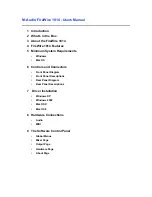
Rear Panel
Rear Panel Descriptions
18.
Power Supply Connector
– Connect the 12VDC 1000mA power supply to this
jack when using the FireWire 1814 with a four-pin FireWire connection. Use only
the power supply provided with the unit or a power supply of an equivalent quality,
with a positive center pin.
19.
MIDI – S/PDIF – Word Clock Connector
– Connect the 15-pin male end of the
breakout cable included with your FireWire 1814 to this DE15F female connector.
This will provide you with the necessary connections for MIDI (standard 5-pin DIN
connectors), coaxial S/PDIF (RCA jacks), and word clock (BNC connectors).
20.
FireWire Connectors
– Dual FireWire (IEEE 1394) ports allow you to connect one
to your computer and the other to an external device. We recommend connecting
only self-powered devices to these inputs. Bus-powered devices may affect your
audio performance.
NOTE:
The FireWire 1814 provides two 6-pin FireWire ports for your convenience. One port is used
for connection to the host computer. The second port allows other peripheral devices to connect to
the host through the FireWire 1814. The FireWire 1814 can receive bus-power from the host
computer, but cannot supply bus-power to an additional FireWire device using the secondary
FireWire port. You must use a power supply with your secondary FireWire device.
21.
ADAT - S/PDIF Optical In and Out Connectors
– ADAT Optical or S/PDIF digital
input and output are provided on optical TOSLink connectors. ADAT vs. S/PDIF
operation can be controlled from the software Control Panel.
22.
Line Outputs 1–4
– These are balanced/unbalanced analog outputs on 1/4” TRS
jacks with signal up to 2.0dBV unbalanced and 8.0dBV (10.2dBu) balanced line
level. When two-channel stereo audio, the signal being monitored are routed
outputs 1 and 2 by default; any or all analog output pairs may be selected in the
FireWire 1814’s Control Panel. You may also use the four outputs to send
individual or grouped channels to a mixing console.



























